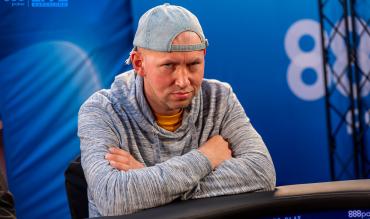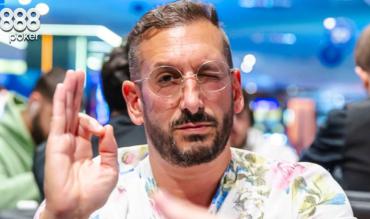Poker isn't all about the cards in our hands; there’s also a significant psychological component. Managing negative emotions is one of the most crucial challenges all players face.
Whether it's the frustration of a bad beat, the anxiety before a big tournament, or the discouragement of a downswing, emotions can derail our focus and performance if left unchecked.
The key to mastering the mental game lies in learning how to handle strong emotions.
The goal isn't to eliminate negative emotions, as they're a natural part of the human experience.
Negative emotions can help us by signalling that something needs our attention. However, if left to their own devices, they can also become overwhelming and counterproductive.
In this 888poker article, we'll share some simple tools and strategies for dealing with negative emotions more effectively. These practical techniques will improve your mental game while supporting your overall well-being.
You'll learn to acknowledge and accept your emotions while reframing negative thoughts.
Understanding Negative Emotions

To effectively manage negative emotions, it's essential to understand what they are and their role in managing our lives. Negative emotions are those feelings that most humans typically find unpleasant or challenging, such as anger, frustration, anxiety, and sadness.
Negative emotions can arise in poker from various situations, such as losing a big poker hand, being card dead, or facing a prolonged downswing. The brain creates emotions to signal that something significant is happening that needs our attention.
For example, feeling anxious before a tournament might highlight a need for better preparation and confidence-building strategies.
While it's natural to want to avoid or suppress negative emotions, there are several reasons why that’s not a good idea.
- First, attempting to avoid negative emotions can exacerbate the very feelings we're trying to avoid.
- When you try to push away or deny an emotion, it typically becomes even stronger.
The best course of action is to manage these emotions so that you can constructively respond while maintaining a cool head.
Acknowledge and Accept Your Emotions

Before you can effectively manage your negative emotions, you must first acknowledge and accept them. It might seem counterintuitive, but acceptance is a powerful tool for emotional regulation.
Ignoring or suppressing emotions can lead to increased tilt and even emotional outbursts, negatively impacting your performance.
Step 1: Recognise Your Emotions
The first step is to recognise your emotions as they arise. Be mindful of your emotional state and identify precisely what you are feeling. For example, after a tough loss (aka a bad beat in the poker dictionary), you might feel a mix of frustration and disappointment.
By pinpointing these emotions, you bring them into your conscious awareness, which is the first step towards managing them.
Step 2: Name Your Emotions
Once you recognise your emotions, the next step is to name them. Labelling your feelings can help you understand what you’re experiencing and why.
Research has shown that naming your emotions can reduce their intensity.
When you label them, practice being precise with your language. For instance, instead of saying, "I'm upset," you could say, "I'm feeling frustrated because my aces got cracked."
This specific identification allows you to address the root cause more effectively.
Step 3: Acceptance
Research shows that accepting our emotions, rather than fighting them, can reduce their impact. Acceptance doesn’t mean resignation; it means acknowledging your feelings without judgment.
This step helps lessen the emotional charge allowing you to focus on constructive actions that are aligned with your goals.

Here's a simple exercise to practise acceptance:
- Observe: Notice the emotion without trying to change it. Pay attention to where you feel it in your body. Has your jaw become clenched, your stomach tightened up, or your heart rate increased?
- Breathe: Take slow, deep breaths to help you stay grounded and calm. A 6-2-7 formation where you breathe in through your nose for a slow count of 6, hold for a count of 2 and exhale through your mouth for a slow count of 7 works. This method ensures a calming, deep breath.
- Allow: Give yourself permission to feel the emotion. Remind yourself that it’s okay, and perfectly normal, to feel this way.
- Reflect: Consider why you might be feeling this emotion and what it’s trying to tell you. Is there anything you need to do to improve your situation?
For example, let’s say you're feeling nervous before a big event – perhaps even a WPT poker tournament. Instead of trying to push away the anxiety, acknowledge it. Say to yourself, "I’m feeling anxious because this tournament is important to me."
Take a few deep breaths, allow the anxiety to be present, and reflect on what actions you can take to prepare better.
This process can help reduce the intensity of your anxiety and enable you to focus on your game plan.
Challenging Negative Thoughts

Acknowledging and accepting emotions is only one part of turning negative emotions into positive ones. The next step is addressing the negative thoughts often accompanying these feelings.
Cognitive restructuring is a technique for identifying and challenging negative thought patterns and replacing them with balanced and constructive ones.
Several patterns of irrational or exaggerated thinking often accompany negative emotions, known as cognitive distortions. These ways of thinking can fuel negative emotions.
Common cognitive distortions include:
- Catastrophising: Expecting the worst possible outcome (e.g., "Losing this hand is proof that I’ll never get out of my downswing”).
- Black-and-White Thinking: Seeing things in extremes with no middle ground (e.g., "I win this tournament, or I'm a terrible player").
- Overgeneralisation: Making broad conclusions based on a single event (e.g. “Allowing myself to get bluffed means I am stupid”).
Once you've identified a cognitive distortion, the next step is to challenge and reframe it.
Here’s how you can do that:
- Pinpoint the exact negative thought that is impacting your emotions.
- Look at the evidence for and against this thought. Force yourself to see both sides. Is this thought based on facts or assumptions?
- Replace the negative thought with a more balanced one. This process doesn’t mean reverting to overly positive thinking. Instead, try to develop a realistic and constructive perspective.

Practical Exercise: Thought Record
Keeping a thought record – similar to tracking your poker combos - is a helpful tool in this process. You can use a notetaking app or find another place to write it out.
Here’s what you should record :
- SITUATION: Describe the event that triggered the negative emotion.
- EMOTION: Identify and rate the intensity of the emotion.
- AUTOMATIC THOUGHT: Write down the automatic negative thought that arose.
- EVIDENCE FOR: List the evidence supporting this thought.
- EVIDENCE AGAINST: List the evidence contradicting this thought.
- ALTERNATIVE THOUGHT: Create a balanced thought that considers the evidence against the negative thought.
Here’s a sample thought record:
- Situation: Lost a significant hand in a tournament.
- Emotion: Frustration (8/10)
- Automatic Thought: I'm never going to win a major tournament.
- Evidence For: I've lost many hands before and have yet to win a major tournament.
- Evidence Against: I've won many hands and tournaments; losing one hand doesn’t define my overall skill.
- Alternative Thought: Losing this hand is just part of the game. I can learn from it and improve my strategy for the next hand.

Regularly practising cognitive restructuring can reduce the impact of negative thoughts on your emotions and performance. It will help you to think more clearly, make better decisions, and be more resilient in stressful situations.
Remember, cognitive restructuring is a skill that takes time and practice to develop.
Start by identifying one or two negative thoughts each day and work through the process of challenging and reframing them.
Over time, this will become a natural part of your mental game routine.
Dealing With Negative Emotions Positively - Conclusion
Managing negative emotions is essential for achieving peak performance, not just at the poker table but in all areas of life.
Understand and accept your emotions.
Then, reframing negative thoughts into something more helpful is the foundation for mastering the mental game.
Mastering your emotions is ongoing and requires consistent effort and practice.
But as you practice these strategies, you’ll improve your overall poker game.


